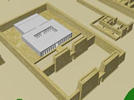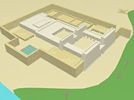| Homepage | Timeline | Maps | A-Z index | Learning |
New Kingdom (about 1550-1069 BC) architecture
Through the good preservation of a few temples and cities we have a better idea of architecture for the New Kingdom than for any earlier period, and even most later periods. Though probably never the administrative centre of Egypt, Thebes was the religious centre for much of the New Kingdom; most of the preserved temples and tombs are there (though other well preserved temples are in Nubia). Amarna in Middle Egypt was the capital of king Akhenaten (Amenhotep IV) and gives many examples of domestic architecture. Memphis was the administrative centre of Egypt. The city is very much destroyed, but some remains of New Kingdom temples and the remains of a palace survived, as well as some imposing tombs in its cemeteries (Saqqara).
(click on the images for more information on the buildings)
Temple architecture
There is a variety of temple types. Among the surviving examples, most common are temples with a pylon, one or more courtyards and the sanctuary at the back.
|
the Aten temple at Amarna
|
temple of Seth at Nubt
|
temple excavated at Gurob
|
temple at Badari |
'west hall' at Memphis
|
The royal funerary complex
Unlike most Old and Middle Kingdom (about 2025-1700 BC) kings, the kings of the New Kingdom are not buried in pyramids. The tomb of the New Kingdom king was placed in a more hidden desert valley in Thebes (exception: the royal tomb of Akhenaten at Amarna). The temple for the king's cult, formerly part of the pyramid complex' was now separated from the burial place and built at the edge of the cultivation at Thebes. In their layout these temples are very similar to the temples for the cults of the gods.
|
the royal tomb at Amarna
|
mortuary temple of Thutmose IV
|
mortuary temple of Merenptah
|
Palaces
There are some substantial remains of royal palaces excavated (for example at Amarna, Malqata or Memphis); others are so far only known from few remains and are now perhaps totally destroyed (Gurob, Tell el Yahudiyeh).
|
Gurob
|
Tell el Yahudiyeh
|
palace of Merenptah
|
Malqata
|
Amarna
|

